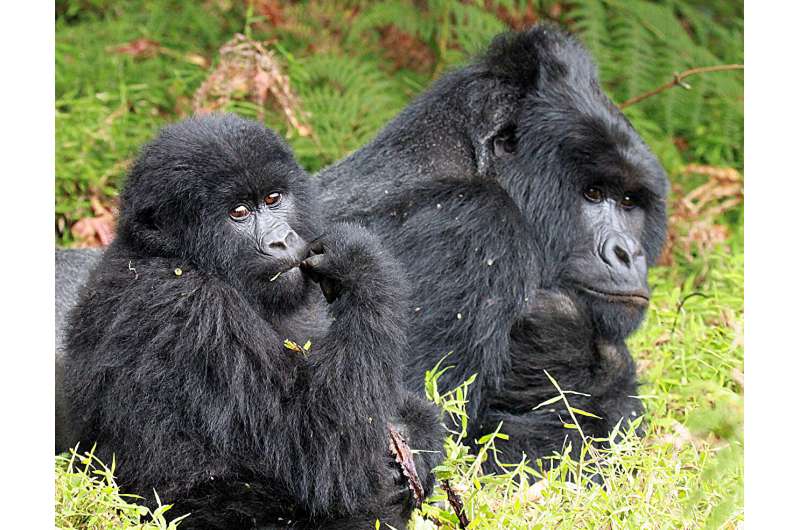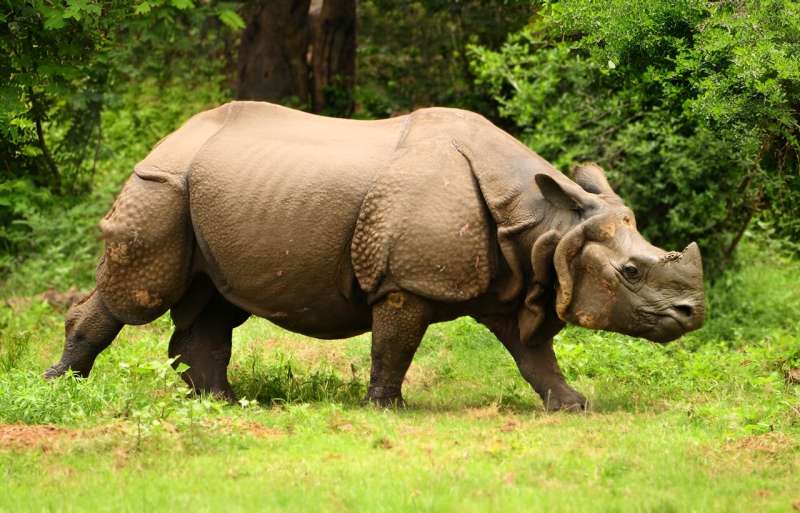Prehistoric men attack an elephant. New research shows that it was humans, not climate, that caused a sharp decline in almost all megafauna on Earth 50,000 years ago. Credit: First printed in Bryant & Gay, 1883. Wood carving by E. Bayard.
For years, scientists have wondered whether humans or climate have caused a dramatic decline in the population of large mammals over the past several thousand years. A new study from Aarhus University confirms that climate cannot be the explanation.
About 100,000 years ago, the first modern humans migrated in large numbers out of Africa. They were adept at adapting to new habitats and settled in virtually every type of landscape, from deserts to jungles to the icy taiga of the far north.
Part of the success lies in man’s ability to hunt large animals. Using clever hunting techniques and specially designed weapons, they perfected the art of killing even the most dangerous mammals.
But unfortunately, the great success of our ancestors came at the expense of other large mammals.
It is well known that many large species became extinct during the era of global colonization by modern humans. Now, new research from Aarhus University reveals that the large mammals that survived have also experienced a dramatic decline.
By studying the DNA of 139 living species of large mammals, scientists were able to show that the abundance of almost all species fell dramatically around 50,000 years ago.
This is according to Jens-Christian Svenning, professor and director of the Center for Ecological Dynamics in a New Biosphere (ECONOVO) of the Danish National Research Foundation at Aarhus University and initiator of the study.
“We studied the evolution of populations of large mammals over the last 750,000 years. For the first 700,000 years, populations were fairly stable, but 50,000 years ago the curve broke and populations fell dramatically and never recovered,” he says. and carry on :
“Over the past 800,000 years, the globe has fluctuated between glacial periods and interglacial periods approximately every 100,000 years. If climate were the cause, we should see larger fluctuations when the climate changed ago is 50,000 years old. But that’s not the case. So humans are the most likely explanation.”
Who killed the big mammals?
For decades, scientists have debated the causes of the extinction or rapid decline of large mammals over the past 50,000 years.
On one side are scientists who believe that rapid and severe climate fluctuations are the main explanation. For example, they think the woolly mammoth became extinct because the cold mammoth steppe largely disappeared.
On the other side is a group that believes the predominance of modern humans (Homo sapiens) is the explanation. They believe that our ancestors hunted animals to such an extent that they either completely disappeared or were severely decimated.
So far, fossils from the past 50,000 years provide some of the most important evidence in the debate. They show that the strong and selective extinction of large animals in time and space roughly corresponds to the spread of modern humans around the world. The extinction of animals can therefore hardly be linked to climate. Nevertheless, the debate continues.
The new study presents brand new data that sheds new light on the debate. By examining the DNA of 139 living large mammals – species that have survived over the past 50,000 years without going extinct – researchers can show that the populations of these animals have also declined over that time. This development appears to be linked to human proliferation and not to climate change.

The eastern gorilla is one of the most declining mammals. Today it only lives in small areas in the Democratic Republic of Congo. Credit: Michalsloviak, Creative Commons
DNA contains the long-term history of the species
Over the past 20 years, DNA sequencing has undergone a revolution. Mapping entire genomes has become both easy and inexpensive, and as a result, the DNA of many species has now been mapped.
The mapped genomes of species around the world are freely available on the Internet. This is the data that the Aarhus University research group used, says Assistant Professor Juraj Bergman, lead researcher behind the new study.
“We collected data on 139 living large mammals and analyzed the huge amount of data. There are around 3 billion data points for each species, so it took a lot of time and a lot of computing power,” says -he and continues:
“DNA contains a lot of information about the past. Most people are familiar with the tree of life, which shows where different species evolved and what common ancestors they have. We did the same thing with mutations in DNA. “DNA. By grouping mutations and building a family tree, we can estimate the population size of a specific species over time.”, and antelopes,
The larger the population of an animal, the more mutations will occur. It’s really a matter of simple math. Take elephants, for example. Every time an elephant is conceived, it is possible for a number of mutations to occur and for them to pass them on to subsequent generations. More births means more mutations. »
Large mammals
The 139 large mammals examined in the study are all species that exist today. They include elephants, bears, kangaroos and antelopes, among others.
There are an estimated 6,399 species of mammals on Earth, but the 139 extant megafauna were selected in this study to test how their populations have changed over the past 40,000 to 50,000 years, when similar large animals have disappeared.
Large mammals are also called megafauna and are defined as animals weighing more than 44 kg as adults. Humans are therefore also considered megafauna. In the study, however, the researchers looked at species weighing as little as 22 kg, so all continents were represented except Antarctica.
Looking at the neutral parts of DNA
However, the size of the elephant population is not the only thing that affects the number of mutations.
If the area in which elephants live suddenly dries up, the animals are put under pressure, which affects the composition of mutations. The same happens if two isolated groups of elephants suddenly meet and mix their genes.

Another large mammal that has been seriously decimated is the greater horned rhinoceros. It lives in India and is one of the five remaining rhino species. Credit: Mayank1704, Creative Commons
If population size is not the only thing that affects the number of mutations that occur, one might think that the results are rather uncertain. But this is not the case, explains Juraj Bergman.
“Only 10 percent of mammalian genomes are made up of active genes. Strong selection pressure from the environment or migration will primarily result in mutations in genes. The remaining 90 percent, on the other hand, are more neutral,” he says and continues:
“So we looked at mutations in the parts of the genome that are least sensitive to the environment. These parts primarily indicate population size over time.”
The woolly mammoth is an atypical case
Much of the debate over the causes of the extinction or decline of large animals has focused on the woolly mammoth. But it’s a bad example because the majority of megafauna species that went extinct were associated with temperate or tropical climates, as Jens-Christian Svenning explains.
“The classic arguments in favor of climate as an explanatory model are based on the fact that the woolly mammoth and a number of other species associated with the so-called “mammoth steppe” disappeared with the melting of the ice and that the type of habitat has disappeared,” he said. ” says and continues: “This is fundamentally an unsatisfactory explanatory model, because the vast majority of extinct megafauna species of the time did not live in the mammoth steppe at all. »
“They lived in warm regions, such as temperate and tropical forests or savannahs. In our study, we also show a strong decline during this period in the populations of the many megafauna species that have survived and come from all kinds of different regions and habitats.”
The end point of the debate is probably not yet set, but Jens-Christian Svenning finds it difficult to see how the arguments in favor of climate as an explanation can continue.
“It seems inconceivable that it is possible to propose a climate model explaining how, on all continents and groups of large animals, there have been extinctions and continued decline for about 50,000 years. And how this selective loss of megafauna has been unique for 66 million years despite enormous climate change.
“Given the wealth of data we currently have, it is also hard to deny that this is because humans spread across the world from Africa and their population subsequently increased.”
The results are published in the journal Natural communications.
More information:
Juraj Bergman et al, Global population declines of extant late Pleistocene and early Holocene megafauna are associated with the expansion of Homo sapiens rather than climate change, Natural communications (2023). DOI: 10.1038/s41467-023-43426-5
Provided by Aarhus University
Quote: People, not climate, caused the decline of giant mammals (December 14, 2023) retrieved December 15, 2023 from
This document is subject to copyright. Apart from fair use for private study or research purposes, no part may be reproduced without written permission. The content is provided for information only.



